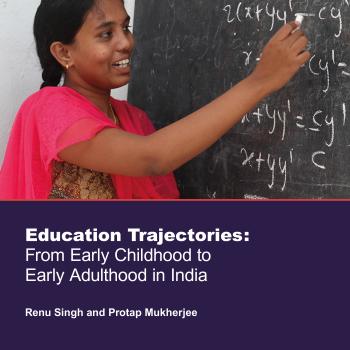
This report draws upon Young Lives longitudinal data gathered in Andhra Pradesh and Telangana to trace the educational trajectories of two cohorts of children since 2002. From this data, it is clear that huge disparities exist in educational outcomes for children, based on wealth index, gender, location and dynamic poverty status. Stratification of better-off children and boys into private low-fee charging schools adds further to the inequity.
The report highlights the increasing inequities and lack of opportunities afforded to children, particularly girls, from chronically poor households. The low educational achievement for children from economically and socially disadvantaged backgrounds needs to be addressed urgently to ensure that education becomes an equaliser rather than a source of increasing division. This would need consistent policies, programmes and public investment targeting educationally vulnerable children from an early age.
Some policy recommendations are: It is critical to focus on early years and ensure that preschool and primary teachers are effectively trained to develop early literacy, so that children acquire skills and retain interest in learning. Given the increase in private school enrolment of children from better-off households, it is important that the Sustainable Development Goals’ focus on ‘quality education’ must become an inherent right for every child irrespective of gender, caste, ethnicity, religion, socio-economic background, ability, or location. Since gender disparity in schooling increases as children grow older, safety nets and social protection for the poorest households must be made available. There is a strong case for an autonomous department of standards and evaluation to be set up and quality standards developed and implemented across all schools. A ‘common school system’ may be the best way forward to ensure that the education system is able to promote equity and social justice.

This report draws upon Young Lives longitudinal data gathered in Andhra Pradesh and Telangana to trace the educational trajectories of two cohorts of children since 2002. From this data, it is clear that huge disparities exist in educational outcomes for children, based on wealth index, gender, location and dynamic poverty status. Stratification of better-off children and boys into private low-fee charging schools adds further to the inequity.
The report highlights the increasing inequities and lack of opportunities afforded to children, particularly girls, from chronically poor households. The low educational achievement for children from economically and socially disadvantaged backgrounds needs to be addressed urgently to ensure that education becomes an equaliser rather than a source of increasing division. This would need consistent policies, programmes and public investment targeting educationally vulnerable children from an early age.
Some policy recommendations are: It is critical to focus on early years and ensure that preschool and primary teachers are effectively trained to develop early literacy, so that children acquire skills and retain interest in learning. Given the increase in private school enrolment of children from better-off households, it is important that the Sustainable Development Goals’ focus on ‘quality education’ must become an inherent right for every child irrespective of gender, caste, ethnicity, religion, socio-economic background, ability, or location. Since gender disparity in schooling increases as children grow older, safety nets and social protection for the poorest households must be made available. There is a strong case for an autonomous department of standards and evaluation to be set up and quality standards developed and implemented across all schools. A ‘common school system’ may be the best way forward to ensure that the education system is able to promote equity and social justice.

